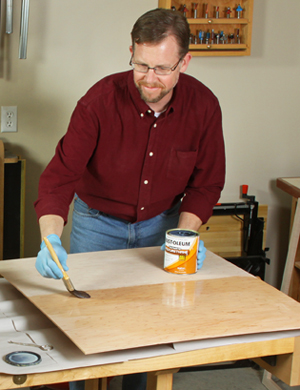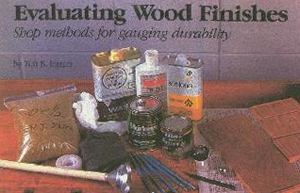
Which is best for interior furniture, acrylic finish or urethane finish and hair brush vs. foam brush? – John Glenn
Chris Marshall: I don’t mean to be evasive, but “best” is a very relative term. Best in what context? Ease of application? Durability to heat, solvents, acids or alkalis? Clarity when fully cured? Low odor and volatility? There are many factors involved with finishes to make that determination, so I’ll offer a personal opinion. Despite its overall durability, I’m not a big fan of oil-based urethane. It’s strong smelling, takes a long time to cure (especially when I don’t have a long time to wait!) and is messy to clean up. I much prefer water-based (acrylic) varnish these days, and specifically Rust-Oleum’s Ultimate Polyurethane. Here’s why: it brushes or pads on easily and levels out beautifully. It dries faster than any other varnish I’ve used — you can apply multiple coats in an afternoon, almost as fast as lacquer. The finish has very little odor when wet, it cleans up with soap and water, and the cured finish is pretty durable. Add all of this up, and to me, that makes a “best” finish for interior furniture. Frankly, I don’t even keep a fresh can of oil-based polyurethane anymore.
All that said, for the highest durability on rough-and-tumble furniture (think kids, pets, high humidity, kitchen use), I would go back to oil-based poly again and endure the smell. It’s tough as nails against the day-to-day spills and scuffs that are part of busy households. Durability is probably the biggest reason why hobbyist woodworkers continue to buy more oil-based poly than any other finish option.
Tim Inman: The age-old questions again come up for discussion. Which is the best finish? There is no best finish. There are finishes better than others — for a set of given conditions. To know which finish is your “best” one, you need to ask yourself some questions about your needs and wants. Both resins provide excellent wood finishes. So, we’re about to go on a hair-splitting mission here. Acrylics are very clear and stable. They typically bond well to their substrates. Urethane resins tend to be a little bit amber of yellow. They typically bond less well to their substrates. So the answer is acrylic! No, not necessarily.
Urethane resins provide superior solvent, impact and abrasion resistance. If your project will be subjected to serious wear and exposure to cleaning chemicals, then I would probably go with a urethane resin base. Good practices and good products negate most of the adhesion issues. Acrylics give the very best color rendition to your stained wood. If spot-on color is high on your list, then acrylic comes back into the picture. Acrylics are more brittle than urethanes, though. So if your project might be subjected to impacts then acrylics take second place again. If smacked, acrylics can shatter. Acrylics are a little easier to recoat later on. Urethanes take second if you need to periodically recoat. Boats and outdoor furniture might be better in this regard with acrylics. So it goes, on and on.
A long time ago, I wrote a program for the Dakota County Community College Woodfinishing Program called, “Evaluating Wood Finishes for Protective Performance Characteristics.” The original program/text is still available for sale in the bookstore on www.historicinteriors.com. If this topic really interests you, or if you are having major trouble falling asleep at night, you might get a copy and read through it.
Fortunately, there are blends of acrylic/urethane finishes on the market. The blends minimize the problems of each resin, and magnify the benefits of the two. I’d go with a blend if you’re unsure. Without question, TEST, TEST, TEST before going full-on to your project. Sample boards are always the way to go when you have questions.
As for brushes: You are asking a real tried-and-true traditionalist here, so factor that bias into my answer. I much prefer true animal bristle brushes, by far and away! Vegetable bristle would be a distant second. Foam brushes are named correctly. They will make your finish foam…. If you will not take the time and pride to correctly clean and store your good animal bristle brushes (which can cost as much as any fine tool on your workbench – or more) then you’re missing out on one of the most pleasurable experiences in completing your project. Nothing is as much fun or feels as good as creating a fine finish and enjoying watching the fluid flow from a good brush. (Well, almost nothing.) But lots of projects get finished in other ways, too. And they do look good. I’m biased to good true animal bristle brushes.
Which one to buy? For general all-around furniture finishing projects, I most often use a 2-1/2-inch bristle/ox brush. Mine are true China boar-hog bristle, mixed with about 15 percent ox hair. The hog bristles come from the ridge on the back of virtually wild boar in very cold climates in China. The ox hair comes from the hair inside the ear of cattle raised in very cold climates (Siberian cattle). I know way too much about bristles. I’ll leave the rest of that discussion for another time. For now, just understand that the boar bristle is a little too stiff, and the ox hair is a little too limp.
Combining the two gives a really nice snappy affordable brush which flows almost as well as sable, or squirrel, which is actually Kolinsky squirrel, which is really a mink-like animal in the martin family and not a squirrel at all, which comes from Siberia and such cold climates. The brush comes from the tail hairs, and there is a difference between male and female hairs. Best brushes are a combination of the two. I use hand-tied Kolinsky brushes for my gilding work. They cost hundreds of dollars each. You don’t need these yet, but why not set a goal?
One last note: If you use a good brush, and keep it clean and stored well, it will last a lifetime. The more you use the brush, the better it gets because the bristles develop a texture which encourages the capillary action which makes the brush hold and flow so well. Get a good natural brush and treasure it.








